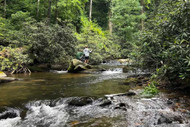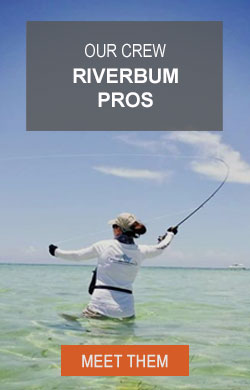Fly Fishing In Tight Quarters : 5 Tips To Help You Catch More Fish
Finding trout in small waters seems like it would be an easy task at first for many anglers as there are simply fewer areas for the trout to seek refuge.
These anglers often overlook the intangible challenges that come with angling many small trout streams in tight quarters.
More often than not, overhanging tree branches, undercut banks lined with woody debris, little room to cast, and less room to set the hook are regular obstacles fly anglers must overcome before figuring out where they plan on fighting the trout.
The good news is, these streams get much less attention from anglers that wish to avoid the hassle of hang-ups, spooking trout, and losing fish for any number of reasons and are left to the dedicated blue liners who enjoy the everchanging puzzle of making creative casts in the skinniest of spaces and are rewarded with trout that see very few fly presentations in their lifetime.
In this article, we will address the gear, the best flies for small streams, the best casts, and most importantly, how to approach these streams to have success with any trout species that inhabit the blue lines in your area.
Gear For Tight Trout Streams and Blue Lines
Many fly anglers opt for smaller 7.5’ 3wt rods for their blue line adventures.
The convenience of moving through tight cover over long distances with a smaller setup is much more convenient than the alternatives. In western water, where tall grasses and shoreline debris line the banks, these can be a great option.
The lack of overhead cover makes conventional cast with a shorter rod possible in many areas and a useful tool for the job.
The smaller rods are also great for enjoying the fights from the smaller trout that often inhabit these streams. In the mountains of Southern Appalachia, these small rods can inhibit anglers. In these blue line streams, the thing rhododendron and mountain laurel-lined banks are accompanied by the overhanging branches from trees, vines, and other vegetation ready to ruin any distracted angler’s day.
While Fly Fishing North Georgia, conventional casts are often out of the question; roll casts, short water hauls, and bow and arrow casts will do the heavy lifting.
Having a 9’ 5wt makes these casts easier and more efficient.
Fly anglers can get an extra 5-10 feet on a standard bow and arrow cast with a stiffer nine-weight rod.
This means more precise casting at a distance and more hookups by the end of the day.
Best Flies For Small Streams
Blue Lines and other small trout streams mean dry flies, dry flies, and more dry flies.
Dry flies will keep you out of the thick brush and hang-ups on the banks and below the surface. Most trout in small water are willing to look to the surface for a meal for the majority of the year.
The summer and fall months make terrestrial patterns such as a Chubby Chernobyl, beetle, or ant a great option.
In the shoulder months, stimulators, elk hair caddis, and Adams patterns are great. The hackles on these fly patterns make the flies more weedless around cover as well.
During the winter and coldest fishing months, anglers may have to go subsurface for bites. Larger flashy nymphs are good options as they attract plenty of attention.
Stonefly patterns, rainbow warriors, or the trusty squirmy worm catch the eye of many small water trout with their larger profiles and flashy nature.
Approaching Small Trout Streams
Trout in small water can be incredibly spooky.
The shallow water and limited cover within the stream leave them exposed to many threats from above. When approaching a stream, there are a few tips to keep in mind.
The first tip is to understand the trout’s position. Trout will be facing upstream nearly one hundred percent of the time.
Being aware of your shadow and silhouette when approaching these fish is crucial.
In faster water, use seams and stronger currents that break up visibility and any water you might push toward the trout during your approach to mask your presence and edge closer.
In calm or flat water, keeping your distance and not pushing water in their direction is imperative for success. Pulses of water will spook trout or shut any active feeding down for some time.
The second tip is to wear earth tones. Pressured trout can see the glow-in-the-dark PFG shirts many wear fishing on the coast from a mile away. Play it safe and opt for dull colors.
This subtle change makes a world of difference on the water.
The third and final tip is to limit your body movement once you are in position. If movement is necessary, opt for slower motions.
Few things are more discouraging than getting in position only to spook the trout while getting your line in order.
Casting in Small Waters
Accurate casting is critical for dissecting the short seams and microcurrents on small water. Anglers often make the mistake of casting far too much and far too long in the small creeks.
This mistake will ruin your drifts by creating additional drag and lead to fewer bites, missed strikes, and waterlogged dry flies, as well as potentially spooking trout with poor execution.
Using stealth to maneuver closer and a shorter cast, anglers can accurately place flies in the targeted seams with more consistency and better results.
High-sticking or keeping your fly line off the water will also improve your chances of landing trout as it minimizes drag and slack for quicker hooksets.
A simple roll cast is typically more than enough to get your fly to your target in typical conditions.
Too much arm waving can give your presence away and leave you searching for new fish.
In areas with a low canopy, water haul casts are great for staying low and getting distance.
In the times when anglers really need to thread the needle, a bow and arrow cast will provide the most accuracy and control.
This is where anglers can make the riskiest cast into the tightest cover.
Slow Down
The last tip for anglers looking to tackle small waters for the first time, or just looking to improve their blue-lining skills is to slow down.
Taking note of all the potential obstacles that may hinder your cast or hook-set will end up saving you much more time retying flies or removing knots from your line.
The majority of these trout will eat on the first cast so long as it’s perfect.
Making this perfect cast on the first cast will lead to landing more trout and spending less time making repetitive casts with no results.
The best small water anglers get there with stealth, efficiency, and attention to detail. By practicing these methods, you can be a master of your local small-water trout streams.







